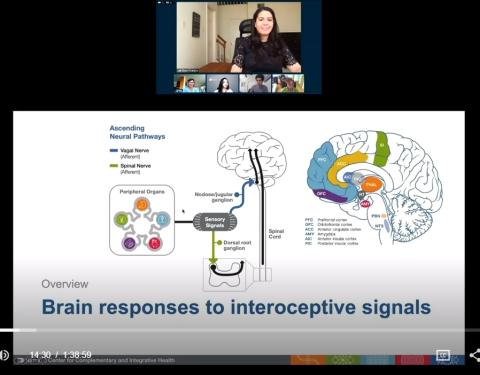What Happens in Vagus
Experts Expound on Interoceptive Processes

Feeling thirsty or tired? With every breath, heartbeat and hunger pang, there’s a vast, intricate maze of neural circuits communicating these signals and sensations between your organs and your brain. Research into these pathways and how they can be modulated by different practices and techniques—from yoga to electrical stimulation—can improve physical and emotional well-being.
Breathing, heartbeat, cravings, fatigue, even pain: these internal processes are part of a mind-body connection called interoception, which encompasses our ability to sense and regulate signals from inside our bodies. Sometimes, we’re not even aware they’re happening.
“Importantly, these processes of sensing, interpreting and integrating include both conscious and unconscious phenomena, factors and mechanisms,” explained NCCIH director Dr. Helene Langevin during introductory remarks at a recent NCCIH virtual webinar.
Focusing on the conscious aspects, Dr. Wolf Mehling, professor of clinical family and community medicine, University of California, San Francisco, said numerous studies have shown that mindful attention toward physical sensations from inside the body changes brain rhythms. He discussed ways to measure interoceptive awareness—how we perceive, sense and respond to the inner workings of our bodies—and how this can be modified with mind-body approaches.
Mehling led an NCCIH-supported team in developing the MAIA scale (multidimensional assessment of interoceptive awareness), a set of questionnaire scales related to self-perception. Physiological tests are important, he said, “but we also should use questionnaires because they’re able to differentiate the [various] dimensions of interoception.”

One key MAIA scale is self-regulation, the ability to regulate distress by paying attention to body sensations, such as our breathing. Mehling cited studies using meditation, yoga and tai chi—incorporating breath awareness—that resulted in reduced pain, fatigue, anxiety and depression.
In a study of patients suffering from chronic low-back pain, three elements on the MAIA scale proved particularly useful: emotion awareness, self-regulation and body-listening. “These 3 were the only scales out of 19 different physiological questionnaires that were able to predict treatment outcomes,” said Mehling.
Another way to probe interoception is to modulate interoceptive pathways via the vagus nerve, the longest cranial nerve, which travels from the digestive tract to the brain. Dr. Eleni Frangos, an NCCIH postdoctoral fellow, focused on afferent pathways, neural circuits ascending from a sense organ toward the brain or spinal cord, or between brain regions.
Studies have shown that focusing on sensations arising from our organs activates the insula, and these interoceptive signals converge and integrate with emotional and cognitive networks across the brain. This complex web of interoceptive awareness has been confirmed in numerous studies, including heartbeat and breathing detection tests.
Electrical stimulation of the vagus nerve can activate multiple brain regions that are involved in interoception. An invasive approach involving implanting electrodes, vagus nerve stimulation (VNS) has been used in patients with treatment-resistant depression and epilepsy and has shown promise in decreasing pain sensation.

“There is plenty of evidence that suggests vagal stimulation modulates affect [or mood] and so much so that it’s an FDA-approved treatment option for refractory depression,” said Frangos. “There’s also evidence that it’s beneficial for other treatment-resistant disorders like OCD, panic disorder and post-traumatic stress disorder [PTSD],” for up to 4 years after implantation.
Newer noninvasive tools can access vagal afferent nerve fibers with a handheld device used externally on the neck or ear. Preliminary research shows beneficial effects in some patients with major depression and anxiety; improvements in memory, learning and reaction time; and reductions in headache pain, said Frangos.
While stimulation of the vagus nerve may reduce pain, so too can mindfulness. “Taking someone’s attention away from a painful stimulus will decrease pain perception, and these psychological factors influence pain perception,” she said. “Manipulating emotion affects pain unpleasantness, while manipulating attention affects pain intensity.”
For the descending (efferent) neural pathways that wind down from the brain to innervate organs and tissues throughout the body, there are various ways to measure this nerve activity. Reliable measurements are important, explained Dr. Jeanie Park, associate professor, Emory University School of Medicine. Chronic overactivity of this efferent sympathetic nervous system can have serious consequences leading to high blood pressure, heart failure or kidney disease.

“Microneurography is the gold standard method by which we can measure and quantify sympathetic activity directly, in real-time, from awake humans,” said Park.
Developed 50 years ago, the technique involves inserting a microelectrode into a peripheral nerve to record sympathetic nerve activity directed to the blood vessels that supply the muscle (i.e., muscle sympathetic nerve activity). This technique offers insights into the effects of modulating interoceptive pathways on the sympathetic nervous system.
“Not only can we use microneurography to characterize baseline resting differences between different patient groups,” said Park, “but we can also study the reactivity of the sympathetic nervous system to stress.”
For example, muscle sympathetic activity tends to be elevated in response to stress in veterans with PTSD. “This is important,” she said, “because exaggerated sympathetic reactivity is associated with increased risk of hypertension and cardiovascular disease.”
Using a biofeedback device, slow breathing—5 or 6 breaths per minute—strikingly lowered the veterans’ muscle sympathetic nerve activity and blood pressure. The mechanisms may include unconscious components (such as activation of baroreceptors, nerve endings sensitive to changes in blood pressure) and a conscious component, such as increased breathing awareness.
Vagus nerve stimulation also inhibits sympathetic nerve activity. A new paper recently reported the first successful vagus nerve recordings using microneurography, showing the nerve can be directly accessed and recorded from awake humans. Said Park, “It really opens up a lot of new, exciting opportunities to study both afferent and efferent vagus nerve activity.”
Further study into interoceptive pathways and how to manipulate them can lead to effective new therapies and preventive strategies. There are potential applications across medicine, from neurology to mental health, pain and addiction, gastrointestinal to cardiovascular health, and across the lifespan.
